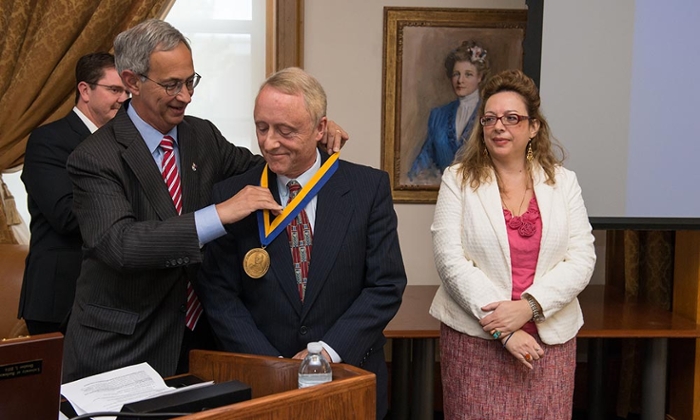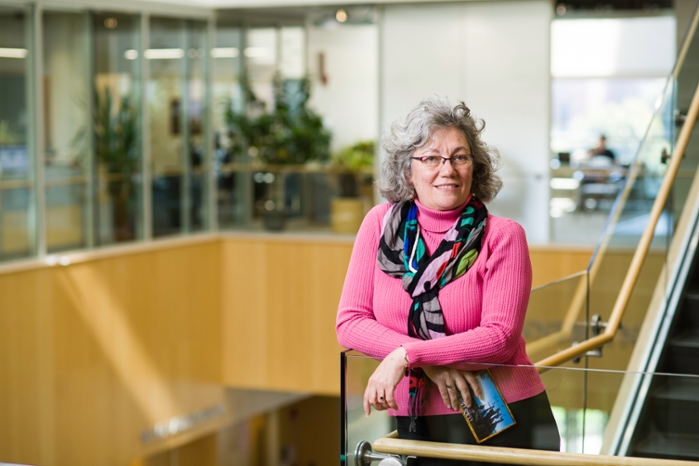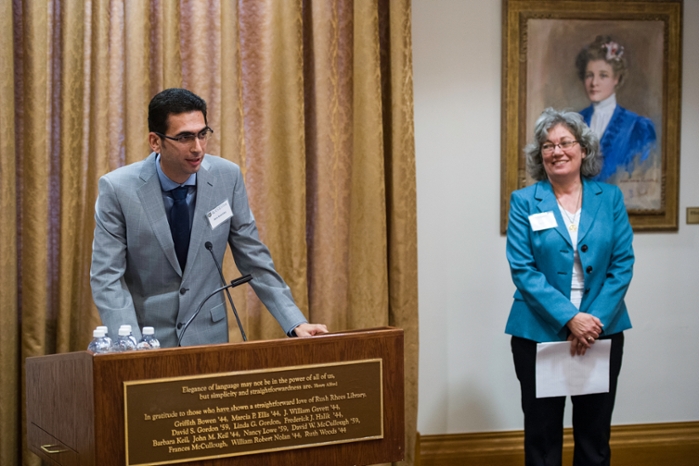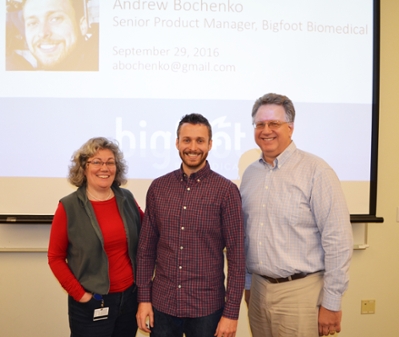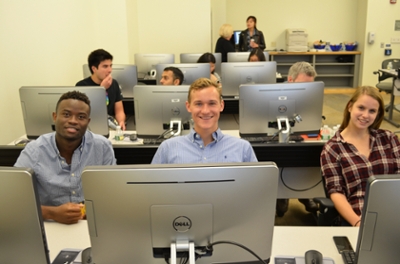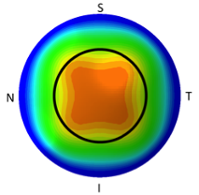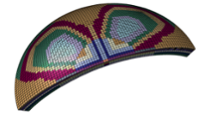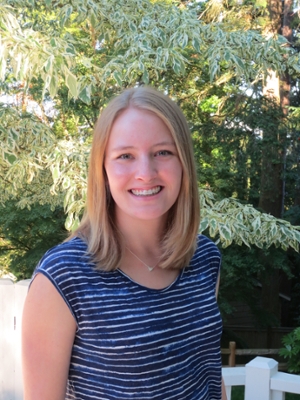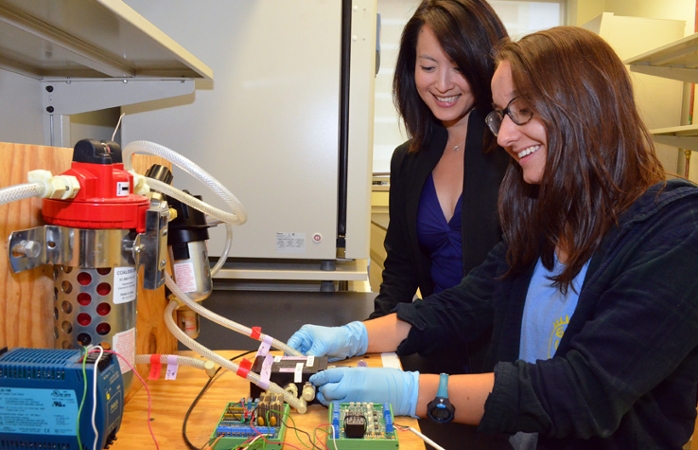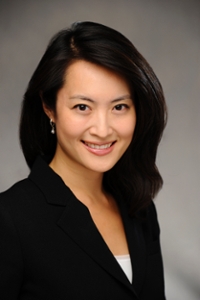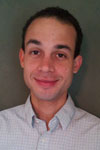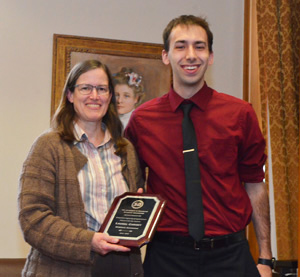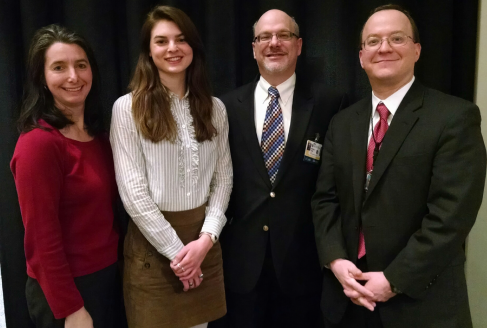2016 News Archives
Professor Miller and URMC colleagues shine light on the flu to develop a better vaccine
The effectiveness of the flu vaccine varies from year to year. Researchers do their best to predict what strain of the virus is circulating, but until now, there was no easy way to take sample from the animals and birds that are carriers of the flu.
BME alum and neurosurgery resident helps develop new way to fabricate artificial organs
 Physicians at the University of Rochester Medical Center (URMC) have developed a new way to fabricate artificial organs and human anatomy that mimics the real thing, even up to the point of bleeding when cut. These models are able to create highly realistic simulations for training and could soon be widely used to rehearse complex cases prior to surgery.
Physicians at the University of Rochester Medical Center (URMC) have developed a new way to fabricate artificial organs and human anatomy that mimics the real thing, even up to the point of bleeding when cut. These models are able to create highly realistic simulations for training and could soon be widely used to rehearse complex cases prior to surgery.
BME alum Ben Freedman shares his experience as a visiting scientist in Puerto Rico
Benjamin Freedman, a graduate student and NSF fellow in the Department of Bioengineering and member of the McKay Orthopaedic Research Laboratoriesin the Perelman School of Medicine, recently spent some time as visiting junior scientist at the University of Puerto Rico Mayagüez. His trip was part of a Howard Hughes Medical Institute program that provides outreach and support to research institutions that predominantly serve groups underrepresented in STEM fields.
Dalecki and Hocking receive UR Technology Development Fund Award
Getting to know graduate student Eric Comeau
This news item is part of a larger series of profiles featuring graduate students and postdoctoral research fellows within the Department of Biomedical Engineering at the University of Rochester.
Professor McGrath receives Dean's Office PumpPrimer II Grant
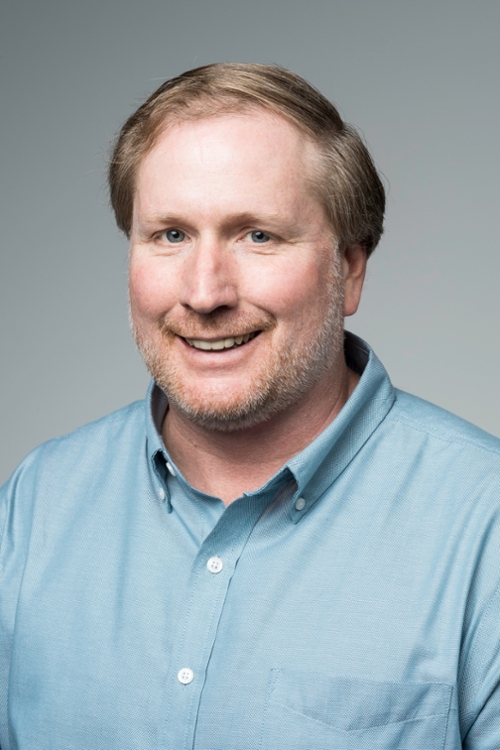 Professor Jim McGrath recently received a Dean's Office PumpPrimer II Grant for his research project titled, "Desalinization with Ultrathin Nafion Membranes."
Professor Jim McGrath recently received a Dean's Office PumpPrimer II Grant for his research project titled, "Desalinization with Ultrathin Nafion Membranes."
Professor Benoit co-PI on NIH funded project: “Salivary gland-specific radio protection”
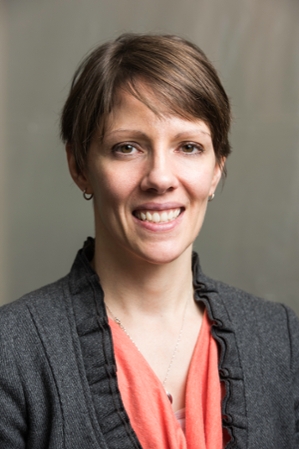 In collaboration with Associate Professor Catherine Ovitt of the Department of Biomedical Genetics, Professor Danielle Benoit is the co-PI on the recently funded NIH research project: “Salivary gland-specific radioprotection.” Briefly, salivary glands are extremely sensitive to ionizing radiation (IR) used as a curative treatment for head and neck cancers. However, mechanisms governing radiation-damage induced losses in salivary gland function is unknown. Therefore, this work focuses on fundamental understanding of salivary gland radiosensitivity and development of therapeutic approaches to protect against damage. If successful these approaches will lend themselves to translation and the development of novel therapy strategies that would improve the quality of life for survivors of head and neck cancer.
In collaboration with Associate Professor Catherine Ovitt of the Department of Biomedical Genetics, Professor Danielle Benoit is the co-PI on the recently funded NIH research project: “Salivary gland-specific radioprotection.” Briefly, salivary glands are extremely sensitive to ionizing radiation (IR) used as a curative treatment for head and neck cancers. However, mechanisms governing radiation-damage induced losses in salivary gland function is unknown. Therefore, this work focuses on fundamental understanding of salivary gland radiosensitivity and development of therapeutic approaches to protect against damage. If successful these approaches will lend themselves to translation and the development of novel therapy strategies that would improve the quality of life for survivors of head and neck cancer.
Three BME graduate students receive 2016 CMSR Symposium Distinguished Abstract Awards
Three BME students were selected to receive a CMSR Symposium Distinguished Abstract Award this year. This new award recognizes outstanding abstracts that were submitted for this years poster session. David Abplanalp and Bentley Hunt are both members of the Awad Lab and Maureen Newman is a member of the Benoit Lab. Below are the winning abstracts for each student:
Christopher Farrar awarded NHLBI Fellowship
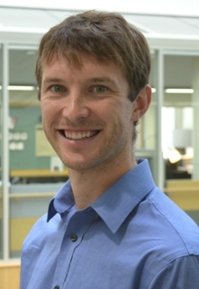 Christopher Farrar, a Ph.D. candidate in the lab of Professor Denise Hocking, has been awarded a Ruth L. Kirschstein National Research Service Award (NRSA) Individual Predoctoral Fellowship (F31) from the National Heart, Lung, and Blood Institute for his project entitled “Influence of extracellular matrix fibronectin on platelet-derived growth factor (PDGF) signaling”. PDGF is produced by a variety of different cell types and stimulates mesenchymal cell proliferation, migration, and gene expression. Together with fibronectin, PDGF plays an important role in angiogenesis and wound repair. In contrast, excess PDGF and abnormal fibronectin matrix deposition are linked to several diseases, including pulmonary fibrosis, atherosclerosis, and certain cancers. The focus of Chris’ project is to determine how mesenchymal cell adhesion to extracellular matrix fibronectin fibrils influences the ability of these cells to respond to PDGF, with the long-term goal of developing new treatment approaches to effectively regulate the sensitivity of cells to growth factor stimulation.
Christopher Farrar, a Ph.D. candidate in the lab of Professor Denise Hocking, has been awarded a Ruth L. Kirschstein National Research Service Award (NRSA) Individual Predoctoral Fellowship (F31) from the National Heart, Lung, and Blood Institute for his project entitled “Influence of extracellular matrix fibronectin on platelet-derived growth factor (PDGF) signaling”. PDGF is produced by a variety of different cell types and stimulates mesenchymal cell proliferation, migration, and gene expression. Together with fibronectin, PDGF plays an important role in angiogenesis and wound repair. In contrast, excess PDGF and abnormal fibronectin matrix deposition are linked to several diseases, including pulmonary fibrosis, atherosclerosis, and certain cancers. The focus of Chris’ project is to determine how mesenchymal cell adhesion to extracellular matrix fibronectin fibrils influences the ability of these cells to respond to PDGF, with the long-term goal of developing new treatment approaches to effectively regulate the sensitivity of cells to growth factor stimulation.
Ross Maddox receives NIH R00 Grant to study role of visual stimuli in hearing
 Professor Ross Maddox received an R00 grant from the National Institutes of Health for his project titled "Visual and Auditory Perceptual Factors Affecting Spatial Release from Masking." When listening in noisy environments, the brain uses differences in the locations of sound to improve understanding. The goal of this project is to investigate the effects of visual stimuli and eye position on the auditory system's ability to leverage these small location differences. It combines new behavioral measures, eye-tracking, and novel metrics of brain activity using electroencephalography so that we may better understand not only healthy listening, but also the difficulties faced by people who have normal hearing tests but still struggle to communicate in noisy settings.
Professor Ross Maddox received an R00 grant from the National Institutes of Health for his project titled "Visual and Auditory Perceptual Factors Affecting Spatial Release from Masking." When listening in noisy environments, the brain uses differences in the locations of sound to improve understanding. The goal of this project is to investigate the effects of visual stimuli and eye position on the auditory system's ability to leverage these small location differences. It combines new behavioral measures, eye-tracking, and novel metrics of brain activity using electroencephalography so that we may better understand not only healthy listening, but also the difficulties faced by people who have normal hearing tests but still struggle to communicate in noisy settings.
Diane Dalecki appointed new chair of the Department of Biomedical Engineering
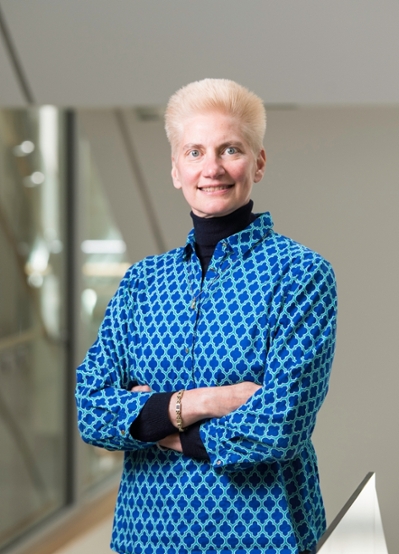 Even before Biomedical Engineering became a department, Diane Dalecki wrote the curriculum for what was then a fledgling interdepartmental program for undergraduates.
Even before Biomedical Engineering became a department, Diane Dalecki wrote the curriculum for what was then a fledgling interdepartmental program for undergraduates.
Benoit receives NIH funding for project: “A novel anti-caries approach to modulate virulence of cariogenic biofilms”
The collaboration of Danielle Benoit, associate professor of biomedical engineering, with Hyun Koo at the University of Pennsylvania School of Dental Medicine, has resulted in a $1,923,792, four-year grant from the National Institutes of Health to further refine their novel approach to fighting dental plaque and tooth decay. Danielle and Hyun have designed nanoparticle carriers that encapsulate anti-bacterial drugs and exhibit affinity to the surface of teeth. When exposed to acidic pH levels that occur due to dietary sugars that cause tooth decay, the nanoparticles destabilize, releasing anti-bacterial drugs exactly when they are most needed. The funding will enable further development of the approach, including coencapsulation and delivery of synergistic anti-biofilm drugs and testing the effectiveness of the approach in rodent models.
BME hosts high school students during Pre-College Summer Program
BME Senior Lab Engineer Kanika Vats taught a biomedical engineering course within the Rochester Pre-College Program to high school students from across the globe this summer. The program welcomes these students to explore the University and its resources in order to broaden their educational experience, sharpen academic skills and expose them to University faculty members. Throughout the week, Dr. Vats taught in a small group setting and mentored the students, giving valuable insight into the theories, technologies and principles of biomedical engineering, while also providing hands-on experiences. The course was entitled. “Biomedical technology: Doctor, Engineering, or both.”
Welcome, freshmen! Map displays BME Class of 2020 hometowns
The Department of Biomedical Engineering is anxiously awaiting the arrival of the new BME freshman class! Below is a map displaying the wide array of locations from which our students will be traveling to join us here at the University of Rochester!
Mark Buckley receives grant from AOFAS
 Biomedical Engineering Professor Mark Buckley received a grant from the American Orthopaedic Foot & Ankle Society (AOFAS) for his research project entitled, "In Vitro Assessment of the Role of Mechanical Strain in the Pathogenesis and Reversal of Insertional Achilles Tendinopathy." Insertional Achilles tendinopathy (IAT) is a common and painful disorder that responds poorly to conservative (i.e., nonoperative) care. Improved outcomes for IAT patients require interventions that target the fundamental causes of the disease. Thus, this study seeks to elucidate 1) how mechanical deformations occurring in the Achilles tendon insertion can lead to IAT pathogenesis (using an in vitro model); and 2) whether the IAT-associated changes can be reversed in vitro by specific mechanical loading regimens. The findings of this study will motivate effective, targeted non-surgical therapies for IAT.
Biomedical Engineering Professor Mark Buckley received a grant from the American Orthopaedic Foot & Ankle Society (AOFAS) for his research project entitled, "In Vitro Assessment of the Role of Mechanical Strain in the Pathogenesis and Reversal of Insertional Achilles Tendinopathy." Insertional Achilles tendinopathy (IAT) is a common and painful disorder that responds poorly to conservative (i.e., nonoperative) care. Improved outcomes for IAT patients require interventions that target the fundamental causes of the disease. Thus, this study seeks to elucidate 1) how mechanical deformations occurring in the Achilles tendon insertion can lead to IAT pathogenesis (using an in vitro model); and 2) whether the IAT-associated changes can be reversed in vitro by specific mechanical loading regimens. The findings of this study will motivate effective, targeted non-surgical therapies for IAT.
Steve McAleavey receives NIH R21 grant
 Stephen McAleavey, associate professor of biomedical engineering, has received a $408,368 R21 grant from the National Institutes of Health for his project, "Quantification of Shear Wave Strain Dependence in Breast Tissues.” Many women presently undergo breast biopsy due to lesions detected with x-ray and ultrasound imaging. The great majority of these biopsies are negative, resulting in needless expense and worry. The goal of this project is to improve the power of ultrasound imaging to predict if a breast lesion is benign or malignant, by using a novel, high-resolution technique to non-invasively map the non-linear mechanical properties of breast tissue. These properties are determined by the microstructure of the tissue and show marked differences between benign and malignant tissues. Stephen’s co-investigators on this interdisciplinary project are Marvin Doyley, associate professor of electrical and computer engineering; Linda M. Schiffhauer, associate professor of pathology and laboratory medicine, and Avice O’Connell, professor of imaging sciences.
Stephen McAleavey, associate professor of biomedical engineering, has received a $408,368 R21 grant from the National Institutes of Health for his project, "Quantification of Shear Wave Strain Dependence in Breast Tissues.” Many women presently undergo breast biopsy due to lesions detected with x-ray and ultrasound imaging. The great majority of these biopsies are negative, resulting in needless expense and worry. The goal of this project is to improve the power of ultrasound imaging to predict if a breast lesion is benign or malignant, by using a novel, high-resolution technique to non-invasively map the non-linear mechanical properties of breast tissue. These properties are determined by the microstructure of the tissue and show marked differences between benign and malignant tissues. Stephen’s co-investigators on this interdisciplinary project are Marvin Doyley, associate professor of electrical and computer engineering; Linda M. Schiffhauer, associate professor of pathology and laboratory medicine, and Avice O’Connell, professor of imaging sciences.
Luebke and Bennetto Explore Hearing Test That May Identify Autism Risk
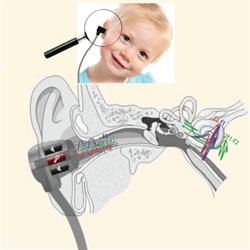 Researchers have identified an inner ear deficiency in children with Autism that may impact their ability to recognize speech. The findings, which were published in the journal Autism Research, could ultimately be used as a way to identify children at risk for the disorder at an early age.
Researchers have identified an inner ear deficiency in children with Autism that may impact their ability to recognize speech. The findings, which were published in the journal Autism Research, could ultimately be used as a way to identify children at risk for the disorder at an early age.
BME students and faculty participate in Xerox Engineering Research Fellows program
 Several of our BME undergraduates are gaining more research experience this summer through participating in theXerox Engineering Research Fellows program, administered by the David T. Kearns Center for Leadership and Diversity in collaboration with the Hajim School and Xerox Corp.
Several of our BME undergraduates are gaining more research experience this summer through participating in theXerox Engineering Research Fellows program, administered by the David T. Kearns Center for Leadership and Diversity in collaboration with the Hajim School and Xerox Corp.
Getting to know PhD candidate Maggie Thomas-Freeberg
This news item is part of a larger series of profiles featuring graduate students and postdoctoral research fellows within the Department of Biomedical Engineering at the University of Rochester.
New York ranks second in terms of academic employment, doctorates awarded and spending on academic R&D
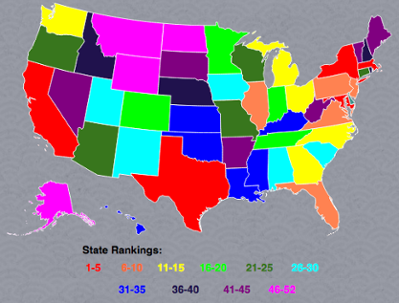 The following maps show where in the United States the most employed science, engineering, and health doctorates are employed, which states awarded the most science and engineering doctorates, and which states spent the most on academic research and development. New York ranks second across the board!Visit the original articlecomplete with interactive maps for more information on how New York stacks up against other states in terms of academic employment, doctorates awarded, and spending. We think you'll be impressed.
The following maps show where in the United States the most employed science, engineering, and health doctorates are employed, which states awarded the most science and engineering doctorates, and which states spent the most on academic research and development. New York ranks second across the board!Visit the original articlecomplete with interactive maps for more information on how New York stacks up against other states in terms of academic employment, doctorates awarded, and spending. We think you'll be impressed.
Nicholas Boldt receives two scholarships to study abroad in Japan
 Congratulations to BME rising junior Nicholas Boldt who was recently awarded two scholarships to study abroad in Osaka, Japan this summer throughCET. The Intensive Japanese Language Program will include language classes, living with a local roommate and attending various cultural activities. Nicholas received both a Benjamin A. Gilman International Scholarship for $5,000 and a Freeman Asia Grant for $3,000.
Congratulations to BME rising junior Nicholas Boldt who was recently awarded two scholarships to study abroad in Osaka, Japan this summer throughCET. The Intensive Japanese Language Program will include language classes, living with a local roommate and attending various cultural activities. Nicholas received both a Benjamin A. Gilman International Scholarship for $5,000 and a Freeman Asia Grant for $3,000.
Manuel Ramirez selected as a 2016 Fight for Sight Summer Student Fellowship recipient
 Congratulations to Manuel Ramirez, a graduate student in the lab of Mark Buckley, who was awarded a summer fellowship from the Fight for Sight Foundation.
Congratulations to Manuel Ramirez, a graduate student in the lab of Mark Buckley, who was awarded a summer fellowship from the Fight for Sight Foundation.
Mruzek and McAleavey's develop device to help potty train children with autism
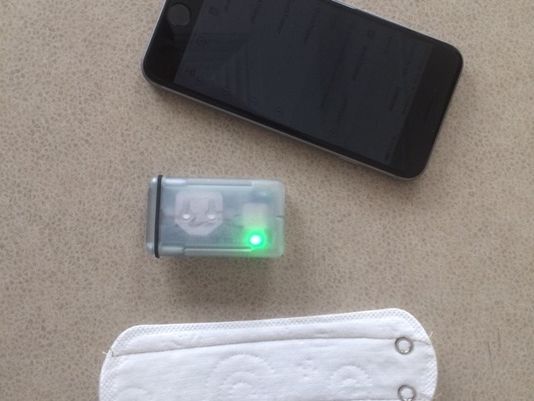 Professor McAleavy and behavioral pediatrics professor Daniel Mruzek believe they have a device that can help parents better potty train children with autism.
Professor McAleavy and behavioral pediatrics professor Daniel Mruzek believe they have a device that can help parents better potty train children with autism.
PhD students in Awad and McGrath Labs place second and third in Falling Walls Competition
The competition is associated with the Falling Walls foundation, a non-profit
organization that fosters discussions on research and innovation and promotes the latest
scientific findings to society. The Rochester winner’s idea will compete with others from
around the world at the Falling Walls Lab Finale in November in Berlin. This event selects
the participants for the annual Falling Walls Conference the following day: an
international forum for science and innovation to commemorate the fall of the Berlin Wall.
Speakers at the conference have included Angela Merkel, Chancellor of Germany; Nobel Prize
winner Sir Paul Nurse; and young inventors from around the world. BBC London said it was
where the “brightest minds on the planet” meet.
Last year’s Falling Walls Lab Rochester winner, Ryan Trombetta, a BME PhD student in
Dr. Awad’s lab, finished 12th (out off a 100 finalists worldwide) in the Berlin competition
for his description of using 3D printed bone grafts to treat osteomyelitis. See his
presentation here.
CMTI students win 2nd place in Mark Ain Business Model Competition
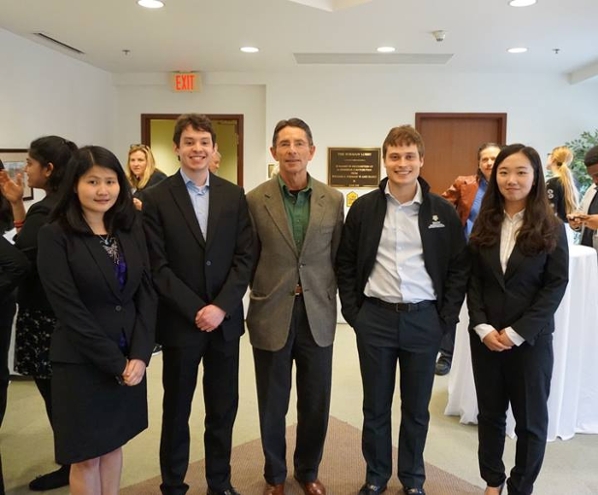 Congratulations to biomedical engineering CMTI graduate students Martin Gitomer, from Princeton, N.J., and Shwe Pyie, from Union City, Calif., who took second place at the 10th Annual Mark Ain Business Model Competition. The team also included BME alum and TEAM graduate student Alin Ponici as well as TEAM graduate student Jia Shi.
Congratulations to biomedical engineering CMTI graduate students Martin Gitomer, from Princeton, N.J., and Shwe Pyie, from Union City, Calif., who took second place at the 10th Annual Mark Ain Business Model Competition. The team also included BME alum and TEAM graduate student Alin Ponici as well as TEAM graduate student Jia Shi.
Taithera, Inc. partners with UR Ventures to Commercialize Bone-Targeted Therapeutic Agent
Taithera, Inc., a New York City based biotech company, and UR Ventures, the technology commercialization office of the University of Rochester, today announced plans to commercialize a bone-targeted therapeutic agent. This precision medicine technology, invented at the University of Rochester’s Center for Musculoskeletal Research, uses a peptide-based approach to deliver drugs directly to the bone for the diagnosis, treatment, and prevention of musculoskeletal diseases and disorders, including osteoporosis, bone cancer, bone fracture, bone allograft rejection, bone autograft rejection, and Paget’s disease.
J. Edward Puzas, Ph.D., the Donald and Mary Clark Professor of Orthopaedics, and Danielle Benoit, Ph.D., Associate Professor of Biomedical Engineering and Chemical Engineering, co-led the development of this technology.
Taithera’s co-founder and Chief Science Officer, Mo Chen, Ph.D. received his doctorate at the University of Rochester and conducted research at the Center for Musculoskeletal Research.
Rochester has been conducting extensive research on this bone-targeting therapeutic agent for more than six years, and animal models show that this bone-targeting technology has high affinity for tartrate-resistant acid phosphatase, an enzyme left by osteoclasts – the cells responsible for bone resorption. This means that drugs can be conjugates, or paired with, this targeting technology to deliver those drugs directly to the bone. This will significantly improve bone biodistribution.
Dr. Benoit said, “I have spent more than a decade developing polymeric delivery systems for biotherapeutics. For the past six years, my research has focused on developing novel targeting systems for bone-specific delivery of therapeutics. The results we have seen from this research show signs of something really quite revolutionary. I am thrilled that the University of Rochester and Taithera are working together to commercialize this technology. I look forward to working closely with Taithera.”
Dr. Chen agrees. “There are few times in a scientist’s career when you see a new technology that stands a strong chance to significantly improve millions of lives,” he said. “The quality of the research and data at the University of Rochester is second to none. It is an honor to once again work with the Center for Musculoskeletal Research at the University of Rochester.”
BME Design Day Projects 2016
Ultranomics –The vast majority of ultrasound sonographers require treatment for Musculoskeletal disorders caused by repetitive, improper ergonomics while at work. We are using real time video motion processing and wearable motion sensors to monitor and log the kinematics of sonographers’ neck and shoulder continuously throughout ultrasound procedures. A GUI displays a graphical representation of ergonomic quality to the sonographer, while quantitative data is saved for further analysis. The information from our ergonomic monitor will identify habits of pathological movement, elucidate the source of injury, and assist with guiding preventative measures.
TEAM: Greg Palis, Megan Routzong, Yanwen Zhai, Mary Bucklin
Customer: Lynn LaPietra, Ph.D., Carestream Health
Supervisor: Diane Dalecki, Ph.D., Biomedical Engineering, University of Rochester
Alex Kotelsky wins 2016 Curtis Award for Excellence in Teaching by a Graduate Student
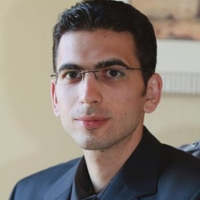 Congratulations to PhD student Alexander Kotelsky of Assistant Professor Mark Buckley's lab. Alex has been named a recipient of a 2016 Edward Peck Curtis Award for Excellence in Teaching by a Graduate Student which comes with a $1,000 prize. "Alex is more committed and skilled in undergraduate instruction than any graduate student I have come across throughout my career," Mark wrote in a nomination letter. "His contribution to the University is nothing short of exceptional."
Congratulations to PhD student Alexander Kotelsky of Assistant Professor Mark Buckley's lab. Alex has been named a recipient of a 2016 Edward Peck Curtis Award for Excellence in Teaching by a Graduate Student which comes with a $1,000 prize. "Alex is more committed and skilled in undergraduate instruction than any graduate student I have come across throughout my career," Mark wrote in a nomination letter. "His contribution to the University is nothing short of exceptional."
Jonathan Langdon wins Outstanding Dissertation Award for Engineering
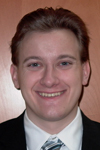 Congratulations to graduate student Jonathan Langdon of the McAleavey Lab who received the prestigious Outstanding Dissertation Award for Engineering this year. This honor attests to Jonathan’s exceptional work in the field of biomedical ultrasound and comes with a monetary award of $1,000. His thesis was titled, “Development of Single Track Location Shear Wave Viscoelasticity Imaging for Real-Time Characterization of Biological Tissues.”
Congratulations to graduate student Jonathan Langdon of the McAleavey Lab who received the prestigious Outstanding Dissertation Award for Engineering this year. This honor attests to Jonathan’s exceptional work in the field of biomedical ultrasound and comes with a monetary award of $1,000. His thesis was titled, “Development of Single Track Location Shear Wave Viscoelasticity Imaging for Real-Time Characterization of Biological Tissues.”
Graduate student Jomy Varghese awarded NCI Fellowship Grant
 Jomy Varghese, a graduate student working in the Benoit Lab, was recently awarded an F30 Fellowship Grant from the National Cancer Institute (NCI). His project is titled “Engineered Nanoparticles to Radioprotect Salivary Tissue” and deals with improving radiotherapy.
Jomy Varghese, a graduate student working in the Benoit Lab, was recently awarded an F30 Fellowship Grant from the National Cancer Institute (NCI). His project is titled “Engineered Nanoparticles to Radioprotect Salivary Tissue” and deals with improving radiotherapy.
BME Junior Omar Soufan to receive Social Entrepreneurship Award
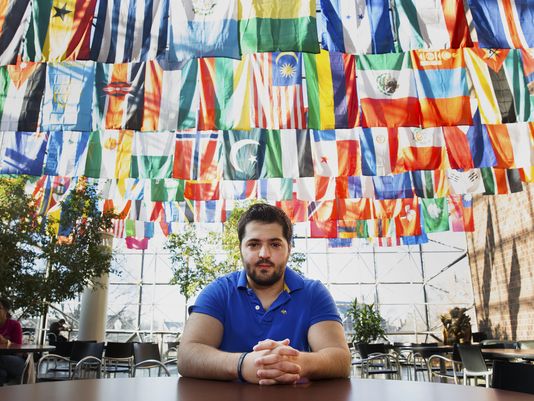
Benoit receives highly competitive score on NIH R01
Danielle Benoit and Hyun Koo of University of Pennsylvania recently received an outstanding score of 8 percent on an NIH Research Project Grant (R01.) The description of their project, “A novel anti-caries approach to modulate virulence of cariogenic biofilms” is below:
Nam Research Article Recommended by F1000Prime
 The research of Jong-Hoon Nam and his collaborators Anthony Peng and Anthony Ricci has been recommended in F1000Prime as being of special significance in its field by a F1000 faculty member. The research, published in June of 2015 is entitled, "Underestimated sensitivity of mammalian cochlear hair cells due to splay between stereociliary columns." F1000Prime publishes recommendations of articles in biology and medicine from a faculty of around 5,000 scientists and clinical researchers and 5,000 more junior associate faculty. The service covers 40 disciplines and around 3,500 journals. Inclusion in F1000 prime indicates that an article has made an impact on the broad scientific areas of biology and medicine.
The research of Jong-Hoon Nam and his collaborators Anthony Peng and Anthony Ricci has been recommended in F1000Prime as being of special significance in its field by a F1000 faculty member. The research, published in June of 2015 is entitled, "Underestimated sensitivity of mammalian cochlear hair cells due to splay between stereociliary columns." F1000Prime publishes recommendations of articles in biology and medicine from a faculty of around 5,000 scientists and clinical researchers and 5,000 more junior associate faculty. The service covers 40 disciplines and around 3,500 journals. Inclusion in F1000 prime indicates that an article has made an impact on the broad scientific areas of biology and medicine.
Mark Buckley among 2016 AOFAS Research Grant Award recipients
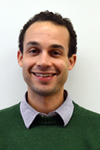 BME Professor Mark Buckley and his collaborators A. Samuel Flemister (Orthopaedics), Alayna Loiselle (Center for Musculoskeletal Research) and Michael Richards (Surgery) were awarded a 2016 AOFAS Research Grant earlier this month for their project entitled, “In Vitro Assessment of the Role of Mechanical Strain in the Pathogenesis and Reversal of Insertional Achilles Tendinopathy.” This was announced at AOFAS Specialty Day on March 5 in Orlando, Florida. Insertional Achilles tendinopathy (IAT) is a common and painful disorder that responds poorly to conservative (i.e., non-operative) care. Improved outcomes for IAT patients require interventions that target the fundamental causes of the disease. Thus, this study seeks to elucidate 1) how mechanical deformations occurring in the Achilles tendon insertion can lead to IAT pathogenesis (using an in vitro model); and 2) whether the IAT-associated changes can be reversed in vitro by specific mechanical loading regimens. The findings of this study will motivate effective, targeted non-surgical therapies for IAT.
BME Professor Mark Buckley and his collaborators A. Samuel Flemister (Orthopaedics), Alayna Loiselle (Center for Musculoskeletal Research) and Michael Richards (Surgery) were awarded a 2016 AOFAS Research Grant earlier this month for their project entitled, “In Vitro Assessment of the Role of Mechanical Strain in the Pathogenesis and Reversal of Insertional Achilles Tendinopathy.” This was announced at AOFAS Specialty Day on March 5 in Orlando, Florida. Insertional Achilles tendinopathy (IAT) is a common and painful disorder that responds poorly to conservative (i.e., non-operative) care. Improved outcomes for IAT patients require interventions that target the fundamental causes of the disease. Thus, this study seeks to elucidate 1) how mechanical deformations occurring in the Achilles tendon insertion can lead to IAT pathogenesis (using an in vitro model); and 2) whether the IAT-associated changes can be reversed in vitro by specific mechanical loading regimens. The findings of this study will motivate effective, targeted non-surgical therapies for IAT.
Awad and Berger receive 2nd percentile score on grant supporting a new method for measuring bone fragility
In February, Hani Awad (Professor of BME) and Andrew Berger (Professor of Optics) received a percentile score of 2% (i.e. top 2%) on a multi-principal investigator R01 grant proposal entitled "Raman spectroscopic platform for transcutaneous monitoring of bone quality.” Their proposed study will develop a noninvasive optical method of measuring bone fragility in arthritic and secondary osteoporosis preclinical models as they receive both anabolic and anti-resorptive medication that try to preserve bone health, which will be validated by biomechanical measures of bone strength and toughness. By providing a better way of tracking bone fragility in living subjects, this work will generate new understanding of how bone disorders develop and how medicines can treat them more effectively. The project Funding is expected to start in the Summer of 2016.
Laurel Carney named Marylou Ingram Professor in Biomedical Engineering
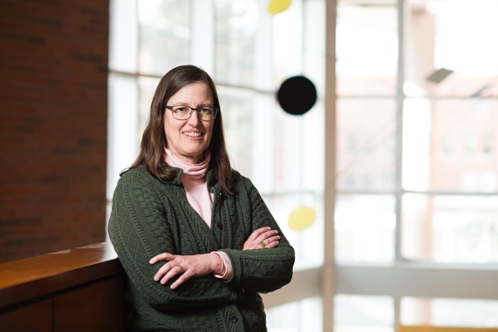 Past the auditory canal, through the eardrum and beyond the cochlea is where you will find the research of Laurel Carney, Ph.D., acclaimed professor of biomedical engineering. Carney’s research focuses on the complex network of auditory nerve fibers that transmit the inner ear’s electrical signals to the brain with the goal of better hearing aids. Her research combines neurophysiological and behavioral studies with computer modeling in an effort to develop hearing aids that make human speech louder and clearer. In June 2015, she earned the William and Christine Hartmann Prize in Auditory Neuroscience from the Acoustical Society of America. And on January 22, the University of Rochester formally installed her as the Marylou Ingram Professor in Biomedical Engineering.
Past the auditory canal, through the eardrum and beyond the cochlea is where you will find the research of Laurel Carney, Ph.D., acclaimed professor of biomedical engineering. Carney’s research focuses on the complex network of auditory nerve fibers that transmit the inner ear’s electrical signals to the brain with the goal of better hearing aids. Her research combines neurophysiological and behavioral studies with computer modeling in an effort to develop hearing aids that make human speech louder and clearer. In June 2015, she earned the William and Christine Hartmann Prize in Auditory Neuroscience from the Acoustical Society of America. And on January 22, the University of Rochester formally installed her as the Marylou Ingram Professor in Biomedical Engineering.
Steve McAleavey receives 9th percentile score for grant supporting ultrasound imaging research
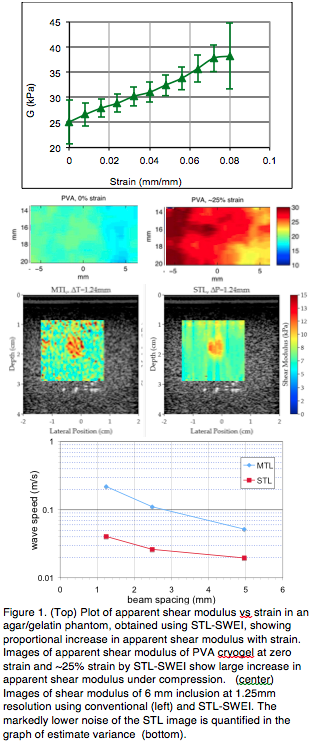 BME Professor Stephen McAleavey recently received a 9th percentile score for his R21 grant entitled, "Quantification of Shear Wave Strain Dependence in Breast Tissues.” Many women presently undergo breast biopsy due to lesions detected with x-ray and ultrasound imaging. The great majority of these biopsies are negative, resulting in needless expense and worry. The goal of this project is to improve the power of ultrasound imaging to predict if a breast lesion is benign or malignant. This will be achieved by a novel, high resolution technique to non-invasively map the non-linear mechanical properties of breast tissue. These properties are determined by the microstructure of the tissue and show marked differences between benign and malignant tissues.
BME Professor Stephen McAleavey recently received a 9th percentile score for his R21 grant entitled, "Quantification of Shear Wave Strain Dependence in Breast Tissues.” Many women presently undergo breast biopsy due to lesions detected with x-ray and ultrasound imaging. The great majority of these biopsies are negative, resulting in needless expense and worry. The goal of this project is to improve the power of ultrasound imaging to predict if a breast lesion is benign or malignant. This will be achieved by a novel, high resolution technique to non-invasively map the non-linear mechanical properties of breast tissue. These properties are determined by the microstructure of the tissue and show marked differences between benign and malignant tissues.
The Future of Photonics
As hundreds of millions of dollars pour into Rochester to establish the nation's first Photonics Hub, biomedical engineering graduate faculty member Ben Miller weighed in on a News 8 special report, "The Future of Photonics."

